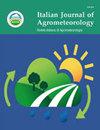Characterization of inter-seasonal climatic variability through dry-season rice productivity in the north-west region of Bangladesh
IF 0.8
4区 农林科学
Q2 AGRONOMY
Italian Journal of Agrometeorology-Rivista Italiana Di Agrometeorologia
Pub Date : 2017-01-01
DOI:10.19199/2017.1.2038-5625.005
引用次数: 7
Abstract
Author(s): Maniruzzaman, M; Muttaleb, MA; Choudhury, AK; Akhter, S; Ahmed, F; Aziz, MA; Rahman, MM; Miah, MM; Biswas, JC; Hamid, MA; Kalra, N | Abstract: © 2017, Patron Editore S.r.l. All rights reserved. Inter-annual climatic variability in Bangladesh is significant and the probability of occurrence of extreme episodic/ climatic events has increased in the last couple of decades and thus threatening food security. Impact of inter-seasonal climatic va riability on Boro rice (dry season) yield in north-western parts of Bangladesh was analyzed using the historic weather datasets for 1971 to 2010 and MAKESENS model. Boro rice yield increased from 1980 onwards and the growth rate picked up with time. Inter-annual and inter-seasonal climatic variability was noticed through maximum and minimum temperatures, rainfall and sunshine hours. In general, temperatures and rainfall showed increasing trends but sunshine hours were decreasing gradually during the study period. Growth rates in average annual maximum, minimum and mean air temperatures were 0.001, 0.016 and 0.009°C year-1, respectively. On regional scale, Boro-rice seasonal maximum temperature was decreasing by 0.013°C year-1 but minimum and mean temperatures were increasing by 0.024 and 0.006°C year-1, respectively. Annual average sunshine hours in the study location were in decreasing trend by 0.027 hr year-1, but reduction in seasonal sunshine hours was 0.035 hr year-1. Inter-seasonal climatic variability was characterized through the Boro-rice yields in four test regions of north-west region of Bangladesh. Trend line equations were evolved for assessing the impact of climatic variations on Bororice yield. If maximum temperature changes by 1oC, Boro rice yield could be increased by 0.13 t ha-1, but it would reduce by 0.34 t ha-1 with one degree rise in minimum temperature. If sunshine hour decreases by 1 hr, Boro rice yield would decrease by 0.70 t ha-1 in study locations. Combined effects of maximum and minimum temperatures and sunshine hours showed significant influence on grain yields of Boro rice. These imply that temperature tolerant and solar radiation use-efficient rice varieties need to be bred for combating climate change impact in Bangladesh. There is a need to identify optimum sowing/transplanting window for the region, choice of suitable cultivars/ideo-types, and adoption of appropriate water and nutrients management strategies and adoption of appropriate resource conservation technologies for sustainable Boro rice production in Bangladesh.孟加拉国西北地区旱季水稻产量对季节间气候变化的表征
作者:Maniruzzaman, M;Muttaleb马;Choudhury, AK党;Akhter年代;艾哈迈德,F;阿齐兹,马;拉赫曼,MM;Miah MM;Biswas JC;哈米德,马;Kalra, N |摘要:©2017,Patron Editore S.r.l版权所有。孟加拉国的年际气候变化很大,极端事件/气候事件发生的可能性在过去几十年中有所增加,从而威胁到粮食安全。利用1971 - 2010年历史气象数据集和MAKESENS模型分析了季节间气候变化对孟加拉国西北部水稻(旱季)产量的影响。水稻产量从1980年开始增加,并随着时间的推移而增加。通过最高气温、最低气温、降雨量和日照时数来观察年际和季节间的气候变化。总体而言,研究期间气温和降雨量呈增加趋势,日照时数呈逐渐减少趋势。年平均最高、最低和平均气温的增长率分别为0.001、0.016和0.009°C。区域尺度上,宝稻季节最高气温下降了0.013℃,最低气温和平均气温分别上升了0.024℃和0.006℃。年平均日照时数呈减少趋势,年平均日照时数减少了0.027 hr,年平均季节性日照时数减少了0.035 hr。通过孟加拉国西北地区四个试验区的硼稻产量,表征了季节间气候变化的特征。发展了趋势线方程,以评估气候变化对硼砂产量的影响。最高温度每升高1℃,水稻产量可提高0.13 t ha-1;最低温度每升高1℃,水稻产量将降低0.34 t ha-1。日照时数每减少1小时,水稻产量将减少0.70 t ha-1。最高、最低温度和日照时数的综合效应对水稻产量有显著影响。这意味着需要培育耐温和太阳辐射利用效率高的水稻品种,以应对孟加拉国的气候变化影响。有必要确定该区域的最佳播种/移栽窗口,选择合适的品种/录象类型,采用适当的水和养分管理战略,并采用适当的资源保护技术,以实现孟加拉国的可持续水稻生产。
本文章由计算机程序翻译,如有差异,请以英文原文为准。
求助全文
约1分钟内获得全文
求助全文
来源期刊

Italian Journal of Agrometeorology-Rivista Italiana Di Agrometeorologia
AGRONOMY-ENVIRONMENTAL SCIENCES
CiteScore
2.10
自引率
8.30%
发文量
6
期刊介绍:
Among the areas of specific interest of the journal there are: ecophysiology; phenology; plant growth, quality and quantity of production; plant pathology; entomology; welfare conditions of livestocks; soil physics and hydrology; micrometeorology; modeling, simulation and forecasting; remote sensing; territorial planning; geographical information systems and spatialization techniques; instrumentation to measure physical and biological quantities; data validation techniques, agroclimatology; agriculture scientific dissemination; support services for farmers.
 求助内容:
求助内容: 应助结果提醒方式:
应助结果提醒方式:


